

|
Home Updates Hydros Cars Engines Contacts Links Contact On The Wire |
Electra Pioneer
|
With the sad death of Ken Smith in 2022 our last link with the company that his father set up has been lost. Ken had always intended to prepare a history of his dad's activities and the company from extensive archives and recollections he had, but unfortunately, ill health prevented this. The Electra Pioneer name was an integral part of the early tethered car scene in the UK, advertising products and services regularly in the specialist magazines, which makes some permanent record important. Without Ken's vital input though, what follows will be based on material and items that exist and memories of many conversations with Ken. The Medway towns in Kent had a number of large engineering and manufacturing sites, with the Naval Dockyard where HMS Victory was built and Shorts Bros, the aircraft company, as major employers. This concentration of engineering skills with the associated model engineering societies and model flying clubs led to a flourishing post war boom in cottage and small industrial production of model related products. |
|
SAC (Sid) Smith, a plumber by trade, began working at Short Bros, the aircraft company, in Rochester after the outbreak of WW2. He was working alongside other employees and enthusiasts who also turned to making model engines after the war. These included Harold Kemp with Kemp Engines, Ken Robinson's Speedwell and Sid's own Electra Pioneer.
|
|
With the banning of the flying of model planes during the war, Sid, along with Ken Robinson and George Thompson turned to running model hydroplanes during their lunch breaks in an area of water created as a reservoir for emergency fire fighting. Although an ardent aeromodeller, Sid had also become interested in tethered hydroplanes in the late 1930s, purchasing a One Metre hydroplane kit from Bond's 'O' Euston Road, with a view to fitting it with a Westbury Atom engine. The boat was completed and then painted by his father who was a professional sign writer, but never fitted out due to the outbreak of the war. The unfinished boat remained in the loft until discovered by his son some 65 years later. Left: Bond's hydro with a Simplex R lodged in the engine bay |
|
In 1941 Sid joined the RAFVR, and by 1944 was a NCO flight engineer, flying Lancaster Bombers with 97 Pathfinder Squadron from Bourn in Cambridgeshire. In March 1944 his crew and others from his flight moved to Downham Market in Norfolk to create 635 squadron, but just nine days later Sid's aircraft was shot down near Mademuhlen in Germany on the infamous Nuremberg raid of 30/31st March. Not all of the crew survived, but Sid joined the 'Caterpillar Club', to become a prisoner of war. In the chaos towards the end of the war, prisoners were being marched eastwards away from the front and it was during one of these forced retreats that the column Sid was in was attacked by an allied Typhoon fighter, so badly injuring him that he lost a leg. He finally ended up in Poland until April 1945 when Stalag Luft 357 was liberated.
The growth of tethered car racing and related model production in the
immediate post war period in the UK was almost exponential. D.A. Russell had
published his Model Race Cars book along with the six pioneering car plans in
1945. Model Car News magazine followed in August 1946 and Model Cars in October,
creating an ever growing demand for engines, cars and parts for the home
builder. |
|
Sid Smith could not return to his pre war employment because of his injury, so it can only be assumed that it was his connections within the modelling world that led him to set up what was initially Electra Engines. The company operated from the family shop in Luton Road, Chatham, although his home in Blenheim Avenue remained the companies address throughout. Both Harold Kemp and Sid had their respective companies up and running very quickly, as both were operating by 1946. Electra was set up soon after Sid's demob and was already well established by the time the first item that can be positively identified was announced via Model Car News in October 1946.
|
|
'Trade Topics' featured 'an interesting bevel gearbox that has been submitted for our inspection and test by Electra Engines (S.A. Smith). The design was similar to the one Bob Curwen used in his Curwen Special, one of the Pioneering designs from Drysdale Publications. The gearbox was available either as a finished unit, with axles and 2:1 bevel gears or as castings with other parts supplied separately. The complete gearbox cost £1-15-0 and the castings just 8/6. The article went on to comment that 'The above firm (Electra Engines) specialises in the construction and re-servicing of model petrol engines for aircraft, boats and cars and have available a wide range of accessories for all types of engine.' An advert early in 1947 mentions 'Specially tuned Kestrel 5cc engines built from super die-castings' at £8-10-0. |
|
The very first advert from Electra was 1/8th page published in MCN in February 1947 'Announcing our latest Product' 'Complete model racing car kit'. 'Price to suit all pockets'. Harold Prately had been commissioned to produce a series of plans of popular racing cars that could be built using commercially available tethered car parts. The Electra kit was based on the Pratley plan for the E type ERA, already modelled by Carl Wainwright and Gerry Buck with his immensely successful 'Topsy'. Pratley had already published a plan for the D type ERA that was based on 1066 Products components and featured as a chapter in Model Car Manual. The E type however was very much lower, requiring a horizontally mounted motor with an offset drive shaft and gearbox, for which the Electra unit was better suited than the full width 1066 version. Right: Electra/Curwen gearbox |
|
|
|
Details in the advert were sketchy, mentioning Dural channel section for the chassis and a 2:1 gearbox. Body was to be built up of wood. Detachable ZN racings wheels or airwheels. No mention was made of the price, only 'Full particulars available on request. Trade enquiries invited'. 1066 Products had been taking half page adverts featuring their engines and engine kits, car parts and kit, along with the elusive hydro since August 1946, putting Electra and Sid at a serious, commercial disadvantage already. The Electra kit was not reviewed until seven months later in Model Cars with a small illustration of a simple chassis with barrelled aluminium channel side frames. |
|
The review reiterated that 'As at present advertised, a wooden body is specified, but it is understood that a kit with a pressed aluminium body may be available later'. Even in September 1947, no price had been announced for the kit and no further adverts were published until October when the kit was then advertised on a monthly basis, but still with no price (and no pressed aluminium body). Unfortunately, despite many printed appeals, Ken was unable to find any further information about this model, no examples were ever featured in the magazines, and none have ever turned up that could be identified. Right: The only known photo of the E type ERA |
|
In the meantime however, what was to become the most recognisable and successful of the Electra Engines products was announced in April 1947 as 'Special Parts for Model Car Constructors'. Chassis parts for the Buck 2A car. These looked very much like the channels from the ERA, splayed at the front for the substantial front cross member, as in the original car. The kits were available at 18/6 per set with 5/8th by 5/8th aluminium channel also available at 2/6 per 18" length. A large number of these kits must have been sold as, even to this day, cars based on the Electra chassis keep appearing. Some are very basic models but some are so close to Gerry Buck's original that purchasers have believed that they had bought 'the real 2A'.
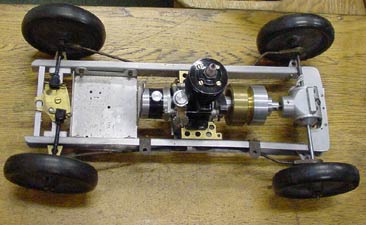 |
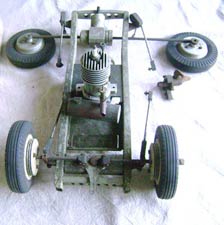 |
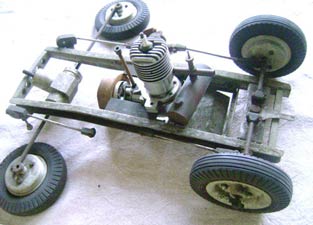 |
| Electra 2A chassis, Roger Howe | 2A discovered in the Chatham area | |
In May 1947, Jerry Cann in his 'Dope and Castor' column reported that S.A.C. Smith of Luton Road Chatham was the newly elected secretary of the Chatham and District Model Car Club and that track facilities have been made available 'by kind permission of Rochester Casino'. Although there was mention of 'two tracks' in the area, no evidence has come to light that a track was ever sited there as the Medway Club established a track at Shaves Wood yard in Rochester that was in use for a while by Ken Robinson, George Thompson and Sid Smith. In an article in Model Cars late in 1947, Smith provided information for those wanting to maximise the performance of their motors and what to look out for in terms of the design. He also presented some gruesome images of crankshaft failures as an illustration.
|
An 1/8th page advert in January 1948 advertised Curwen Special gearboxes at £1-15-0 and 'Special Gearboxes' tested to 100mph at £2-5-0. In addition there were ribbed racing wheels, auto clutches and the Buck 2A chassis kit. That was the last advert that appeared for many months. The January 48 issue of Model Cars include a British engine review, which remarked that Smith had been busy in 1947 designing and building a 10cc motor. This was described as 'Another new and interesting engine developed especially for model racing cars is the "Pioneer 10". According to the review this was aimed at competing directly with the American motors available at the time. The Pioneer 10 was very much based on the American Hornet with a bolt on cylinder and rear rotary valve induction. It was produced in two versions, the standard spark ignition and one with an extended rear shaft for magneto ignition. The engine was priced at £8-10-0 or £12-12-6 with a magneto. |
|
|
|
A further note was that 'it was hoped to produce a 5cc version on similar lines'. Oddly, no further adverts for Electra products were placed in MCN after January 48, although information was included in editorial material. Very confusingly though, in May 1948, MCN reports that 'We have received particulars of the "Pioneer 5" engines from Messrs Electra Engines of 180/182 Luton Road Chatham'. After a brief description it then went on to say 'We understand a 10cc version, the "Pioneer 10" is under construction'. The price and particulars of both types can be obtained from the manufacturers. It was not until July 1948 that a photo of the two engines appeared. |
|
The 5cc motor did have a rear rotary valve and an extension shaft for a magneto, but in other respects was not incorporating the more modern design features of the 10cc and the positioning of the mounting lugs made it far from ideal for use in a model car, other than the American 'midget' designs. Unfortunately, these motors were being introduced into an increasingly crowded market with 1066, North Downs Engineering and Rowell all supplying purpose designed racing engines and advertising them prominently. Smith's fellow tether car enthusiast, Ken Robinson, was also producing his own 10cc 'Speedwell' motor at the same time. It was not until September 1948 that a ¼ page advert appeared with the rather grand announcement that 'Electra Engines proudly present The Engines of the Year'. Pioneer Series 5cc and 10cc etc. No photos of the engine though, as that would have required the expense of blocks but 'Photographs can be supplied if required at 1/- each.' The advert also stated 'Built For The man Who Demands The Best'. |
|
|
|
The same advert continued for a couple of months until December when it was amended to include a 2.5cc motor in the Pioneer Series. C Class racing for 2.5cc engined cars had been proposed in 1947, to which manufacturers responded rapidly with new models. The move to smaller cars and engines also brought in a number of new companies with kits, parts and new models for the class. No further details of the smaller engine were forthcoming leading to much speculation over the years as to its design or even if it was a twinshaft motor. What was also ever more apparent was that all the other manufacturers were posting large adverts every month, with photographs of their products and that they were getting regular mentions in reports. Engines in particular were being submitted for testing with double page reviews by the likes of Lawrence Sparey and Peter Chinn. As a one man band ex serviceman, and without a large company behind him, Sid Smith was at a considerable disadvantage, seemingly deriving most of his income from preparing, servicing and repairing others engines. Indeed, he continued to advertise these services and received glowing tributes about these from customers and in reports from trade reviews in MCN and Model Cars. |
Initial information about the new 2.5cc model was published in a kit review, where 'Advance details of another series of kits are to hand, this time in the under 2.5cc Class.' The proposed Electra model was to be a smaller version of the E type ERA, but this time with a two piece body, the pan and top cast in DTD 424 aluminium in the style that Oliver later adopted so successfully. A separate spur drive engine mount was included that 'Can be supplied to fit any existing British engine of under 2.5cc.' 'A further kit (by Electra Engines) is in course of preparation, this time for upright engine mounting.' This car was to bear a close resemblance to the GP 750cc Austin and comparable in size to the American Thimbledrome cars.
|
The car was finally introduced to the public via an advert in July 1949 that somewhat oddly, had the first proper photo of the Pioneer 10. The ad, reproduced here, announced the car as The Clubman Special 'C' Class Racing car. Still no prices, although an SAE would procure 'Our new catalogue.' Despite the best efforts of Ken Smith, no examples of either version of the car or any further details have ever been discovered apart from one very indistinct photograph. Ken does remember having one of these in his childhood as a 'push along toy car' though, to confirm that it did exist. Electra has stopped advertising in the Percival Marshall published Model Car News at the beginning of 1948, only placing ads in Model Cars to whom he was also relaying information about products, to be included in editorials, Dope and Castor gossip columns, and trade reviews. With the exception of one photo of the Pioneer 10 and 5 and one of the ERA chassis kit, the only other photo was of the Curwen gearbox that Edgar Westbury used to illustrate his construction articles. Model Cars was not published between July 1949 and January 1950 making the announcement of the 'Clubman Special' the last mention of Electra Engines or their products. |
|
By 1950, the tethered car scene in the UK was changing significantly, with many of the firms set up in the immediate post war period struggling. This was not helped by the High Court ruling over purchase tax being payable on model related items, Harold Kemp having already sold his company in 1948. Within a very short space of time, both Model Cars and Model Car News ceased publication, along with several companies manufacturing tethered car related items shutting up shop, including 1066 Products and other high profile operations. Sid Smith was in a doubly difficult situation as a 'one man band' in the shrinking domestic market, but ironically it was a sizeable export order for smaller engines that could have ensured his future, which ultimately was the final 'nail in the coffin' for Electra Engines. Knowing that he did not have the capacity to machine and build all the engines required, he made arrangements with an acquaintance who ran a larger, and better known engine operation to do all the machining work for him. Having passed on the prototypes and drawings to this company, he was dismayed to find that not only had he been sidelined over the order, but that his engines were appearing under the name of the larger company.
This duplicity contributed significantly to the demise of Electra Engines, with the whole incident rankling with him and weighing on his mind for much of the rest of his life. Sid did continue to do some sub contracting work for local aircraft companies, but with his disability was unable to find permanent work. The Luton Road premises were closed as a result and what work he had was carried out at Blenheim Avenue from then on. Unlike most of the other companies of the period though, almost nothing remained of the products, as a catastrophic fire destroyed all records of the model related activities of Sid Smith and Electra Engines including remaining engines, along with other items, and associated equipment that he had retained. In later life, he was known to wax lyrical about 'pedantic collectors' who would denigrate an engine for having the 'wrong screws or needle valve'. As confirmed by other manufacturers of the period, he pointed out that in the immediate post-war period, unless you were producing for the export market, sourcing new fixings and materials was impossible. Engines were put together with whatever screws and nuts were to hand or could be obtained as surplus, so there was no guarantee that all the screws in one engine would match, let alone in a production run.
The only evidence of the involvement of Electra Pioneer in tethered car and model engine manufacturing that survives is what little that was printed at the time and subsequent discoveries. Not even a catalogue or price list appears to have survived, just the fabulous shop sign in the heading. Little had remained or surfaced though until the 1990s, and even now, any Electra or Pioneer items remain the most elusive of British discoveries. The only exception to this is the Buck 2A chassis kits that are still emerging and easy to identify, around ten to date. Only one example of the Pioneer 10c was known to exist, a spark ignition version with a tail shaft owned by Miquel de Rancougne and a very distressed 5cc that was discovered by Miles Patience.
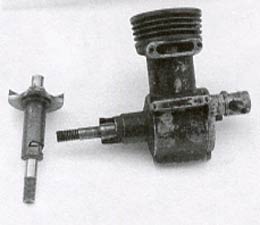 |
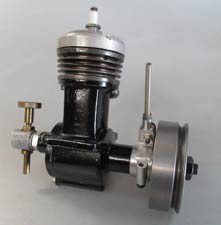 |
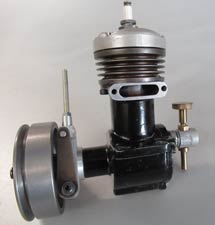 |
| Pioneer 5 as found | Superbly restored by Sid and Ken Smith | |
There was also a selection of parts that Ken Smith believed to be the basis of the 2.5cc engine, but that was it. In 1998 John Goodall bought the mortal remains of the 5cc engine, which Ken Smith offered to restore, with the help of his father some fifty years after having originally built it. Ken believed that no more than twenty examples of the 5cc motor were ever made, making this the only known survivor. This restoration will form the basis of a later update to this article, first published in Model Engine World in September 1998.
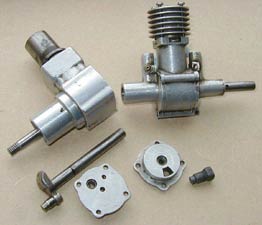 |
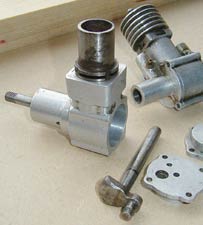 |
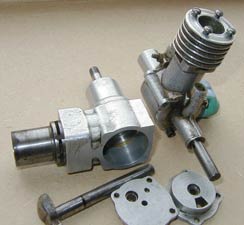 |
| Selection of parts believed to be the elusive 2.5cc motor being used as the basis for a twinshaft | ||
Sid Smith died in 2000 followed by the death of Miquel de Rancougne shortly after. This resulted in the two huge sales of Miquel's cars and engines, the first at Christies in 2004, which included a complete Electra Buck 2A and the only known Pioneer 10. The sale of this engine resulted in an interesting piece of subterfuge as it was included in a lot with several other motors that sold for far more than Ken, or indeed most of us could justify. Ken was not going to get his Pioneer, but then a strange series of events unfolded. The engine appeared on ebay as the purchaser of the lot only wanted one particular engine, so was selling the rest on. I notified Ken of this, but he did not want to bid on it as his ebay trading name would reveal who he was and probably bump up the price, so would I bid on his behalf? In the end, this rare British engine did not create any interest and Ken had his first Pioneer 10 at a very affordable price.
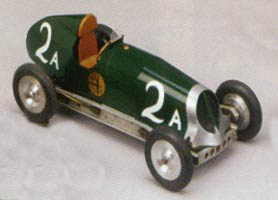 |
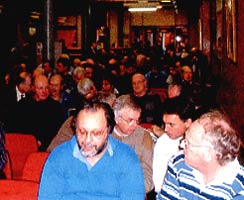 |
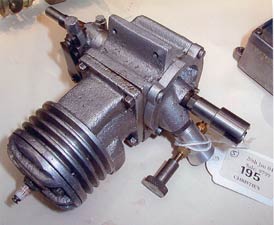 |
| Electra based 2A at Christies | Ken Smith at de Rancougne auction | First Pioneer 10cc to be found |
Later, Ken found a glow plug ignition version of the 10cc in his quest to acquire examples of his dad's engines and finally, a Pioneer 5cc. A hitherto unrecorded Pioneer 5cc emerged in the auction of Doug Walton's collection at Nottingham in 2009, which Ken had hoped to buy. Such was the chaos of that sale though, with multiple engines in each lot, high reserves and little bidding action, this was not to be and the engine has now disappeared again. As far as is known, these are the only five Pioneer motors to be discovered, although there may be more lurking in collections or as yet unidentified.
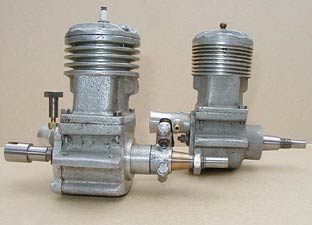 |
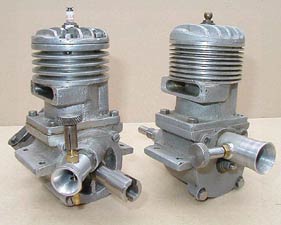 |
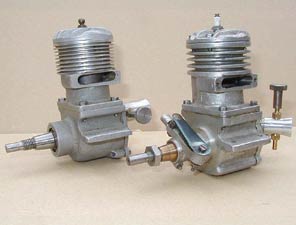 |
| The only two 10s known to exist. The de Rancougne Pioneer 10 with later glow ignition version. Note difference in crankcase castings | ||
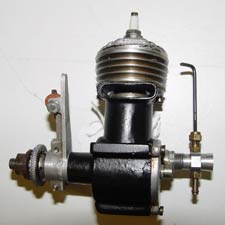 |
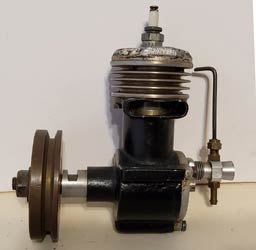 |
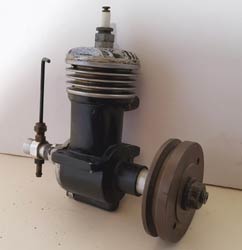 |
| Walton Pioneer 5 | Pioneer 5, just the third discovered to date | |
Piecing together this story has been very difficult with so little material having come to light, and without Ken's willingness to share a huge amount of personal information, verging on the impossible. Modern technology reveals that the Luton Road premises are still there although now two dilapidated terrace houses and a flat. Blenheim Avenue is part of a terrace with some interesting architectural elements, Shorts has long gone, as has the Shaves yard track. There may still be a price list or catalogue waiting to be discovered somewhere and further examples of the engines and chassis kits may yet surface, but until then, this is all we know of Sid Smith and Electra Pioneer.
The inspiration for this article came from the late Ken Smith, and could not have been completed without the generous help of Jan Smith and the unique images she has allowed us to use, including that of the original shop sign that heads the article. This was painted and sign written by Sid Smith's father, removed from Luton road, remaining at Blenheim Avenue before finding a space in Ken and Jan's loft. Thanks are also due to John Goodall for images of his Pioneer 5
©copyrightOTW2023